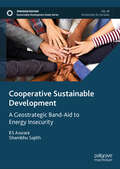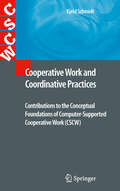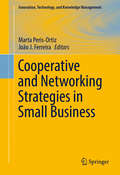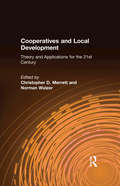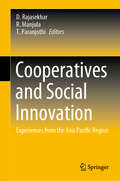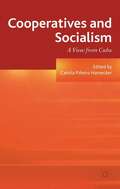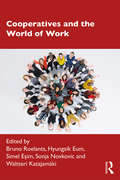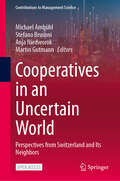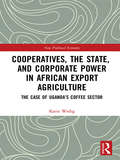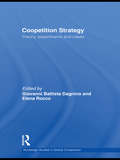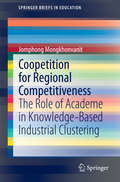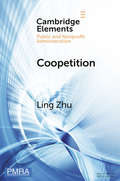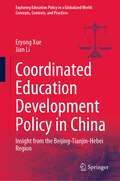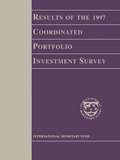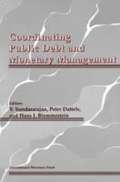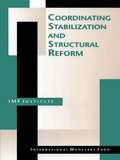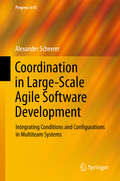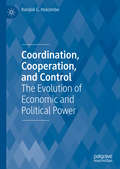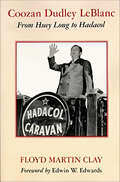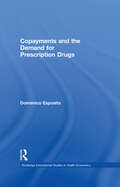- Table View
- List View
Cooperative Sustainable Development: A Geostrategic Band-Aid to Energy Insecurity (Sustainable Development Goals Series)
by RS Aswani Shambhu SajithThe pursuit of energy security and climate action is inextricably linked to the intricate web of geopolitical dynamics. This book offers a fresh perspective, masterfully weaving together the threads of energy, geopolitics, and sustainability to create a powerful tapestry of insights and solutions. It delves into the United Nations Sustainable Development Goal 17, emphasizing the need for multi-stakeholder collaboration to revitalize global partnerships and align countries towards a shared vision for climate action. It introduces the innovative concept of Cooperative Sustainable Development (CSD), which synergizes energy security, climate action, and geopolitical dynamics. Delving into the heart of the Indo-Pacific region, a crucible of power struggles and resource competition, the authors expertly navigate the complexities of this geostrategic chessboard. Through meticulous research and incisive analysis, they unveil the intricate interplay between energy insecurity, political tensions, and the urgent need for climate action. Utilizing a multi-dimensional approach, this book offers readers a comprehensive, one-stop resource for understanding the geopolitics of energy and the path towards a peaceful, stable, secure, and clean Indo-Pacific powered by renewable energy.
Cooperative Work and Coordinative Practices: Contributions to the Conceptual Foundations of Computer-Supported Cooperative Work (CSCW) (Computer Supported Cooperative Work)
by Kjeld SchmidtInformation technology has been used in organisational settings and for organisational purposes such as accounting, for a half century, but IT is now increasingly being used for the purposes of mediating and regulating complex activities in which multiple professional users are involved, such as in factories, hospitals, architectural offices, and so on. The economic importance of such coordination systems is enormous but their design often inadequate. The problem is that our understanding of the coordinative practices for which these systems are developed is deficient, leaving systems developers and software engineers to base their designs on commonsensical requirements analyses. The research reflected in this book addresses these very problems. It is a collection of articles which establish a conceptual foundation for the research area of Computer-Supported Cooperative Work.
Cooperative and Networking Strategies in Small Business (Innovation, Technology, and Knowledge Management)
by Marta Peris-Ortiz João J. FerreiraThe book aims to collect the most recent research and best practices in the cooperative and networking small business field identifying new theoretical models and describing the relationship between cooperation and networks in the small business strategy context. It examines different concepts and analytical techniques better understand the links between cooperative strategies and networks in small business. It also studies the existing economic conditions of network and strategic implications to small business from the point of view of their internal and external consistency. Cooperation and networks is a fashionable topic. It is receiving increasing attention in popular management publications, as well as specialized academic journals. Cooperation between firms and industries is a means of leveraging and aggregating knowledge also generating direct benefits in terms of innovation, productivity and competitiveness. Various options and decisions made within the framework of strategic alliances may be identified and differentiated. For example, it has been argued that R&D cooperation between competing firms also facilitates the search for incremental efficiency gains and is thus a competitive advantage. In parallel with a theoretical acceptance of the importance of a sustained competitive advantage to formulate strategy, there is a growing understanding that cooperative and networking behavior among small firms is at the root of many success stories in today's small business management. This condition requires an effort to develop a study of both aspects of cooperation and networks as compatible, complementary facets of a unique reality. In short, the cooperative and networking relationships of a small business can be the source of its competitive advantage. Enhancement of local resources and capabilities for the generation and dissemination of knowledge is still an issue for defining public policies in many countries. Featuring contributions covering such topics as green innovation, social commerce, university cooperation networks, and regional entrepreneurship, this book provides a comprehensive and richly illustrated study of cooperation and networks in small business that will be pertinent to students, academics, professionals, scholars, and policy makers.
Cooperative and Work-Integrated Education in Asia: History, Present and Future Issues (Routledge Research in International and Comparative Education)
by Yasushi Tanaka Karsten ZegwaardIt has been over a century since "Cooperative System of Education," a work-study programme for higher education, was initiated by Herman Schneider at University of Cincinnati in the United States. Today, it is known as "Cooperative Education" which is commonly included within the umbrella term of "Work-Integrated Learning" and broadly referred to by the World Association of Cooperative Education (WACE) as "Cooperative and Work- Integrated Education (CWIE)". Its development worldwide has been closely related to the socioeconomic background of the region. This book offers the first attempt to focus on the development of CWIE in Asia. To date, the development of CWIE in the Asia region has been slow compared to their counterparts. The analysis follows international comparisons of China, Japan, Korea, Hong Kong, Vietnam, Thailand, Malaysia, and Singapore on their educational history, vocational education, CWIE, and future issues. Although the level of development varies among them, there is no doubt that this region as a whole is experiencing a rapidly growing global demographic and economic prominence. CWIE can, and to some extent already does, play an important, supportive role as part of growth. The book goes on to conclude that in order to enable further successful expansion of CWIE, and improve its best practice, it is imperative to establish national and regional associations for CWIE, as well as establish collaborative research activities across the region with governmental funding support.
Cooperatives and Local Development: Theory and Applications for the 21st Century
by Norman Walzer Christopher D. MerrettFirst Published in 2004. Routledge is an imprint of Taylor & Francis, an Informa company.
Cooperatives and Social Innovation: Experiences from the Asia Pacific Region
by D. Rajasekhar R. Manjula T. ParanjothiThis book discusses social innovations by cooperatives from the Asia and Pacific region. Social innovations emerge when the state and market in developing countries find it difficult to solve problems such as poverty, hunger, ill health, poor education systems, inadequate drinking water and poor sanitation. These countries also face barriers to economic growth such as climate change, poor governance, unequal opportunities and social exclusion. This volume therefore addresses the following questions. What are the distinctive features of social innovations by cooperatives? How social innovations bring in changes in the process and outcome of development? After presenting theories of social innovation and a critical review of cooperatives and social innovation, the book presents 15 chapters on social innovations by cooperatives in the Asia Pacific region. These social innovations are related to health insurance, community based tourism, disaster response, climate smart agriculture, use of social media for youth empowerment, training for the emergence of second-line leaders in cooperatives, social inclusion through innovative finance, profitable marketing of organic produce to strengthen economic status of small farmers, digital auction and value addition for income security of farmer members, collaboration between cooperative members and workers for the mutual benefit, worker cooperatives, women leadership and participation, building union-cooperative partnership in finance and rating of cooperatives to promote transparency and accountability. A chapter on innovative services of cooperatives during the time of Covid19 is also included. This volume will be quite significant for co-operators, researchers, teachers, practitioners and policy-makers at the global level. The theme is relevant for international development community and national cooperatives with concern for their communities, which is the seventh cooperative principle of International Cooperative Alliance and the Sustainable Development Goal of the UN.
Cooperatives and Socialism: A View from Cuba
by Camila Piñeiro HarneckerThis book demonstrates that the cooperative model is based on principles essential to building a more just and democratic society. It is argued that this is the best economic reform alternative to neoliberal capitalism and authoritarian socialism in Cuba, and that this model can also radically transform other economies around the world.
Cooperatives and the World of Work
by Sonja Novkovic Bruno Roelants Hyungsik Eum Simel Esim Waltteri KatajamäkiAs the world of work and jobs is more uncertain than ever because of various trends impacting it, including the rise of robotics and the gig economy, Cooperatives and the World of Work furthers the debate on the future of work, sustainable development, and the social and solidarity economy of which cooperatives are a fundamental component. Throughout the book, the authors, who are experts in their respective fields, do not limit themselves to praising the advantages of the cooperative model. Rather, they challenge the narrow understanding of cooperatives as a mere business model and raise debate on the more fundamental role that cooperatives play in responding to social changes and in changing society itself. The book is unique in tracing the historical connection between cooperatives and the world of work since the end of the First World War and the recent shifts and restructuring in enterprise and the workplace. It presents a redefinition of the very concept of work, focusing on organizational innovation. This book is published in recognition of 100 years of the International Labour Organization, and gathers together research from leading experts who were brought together at an event co-hosted by the International Co-operative Alliance (ICA) and the International Labour Organization (ILO).
Cooperatives in an Uncertain World: Perspectives from Switzerland and Its Neighbors (Contributions to Management Science)
by Stefano Brusoni Martin Gutmann Michael Ambühl Anja NiedworokThis book focuses on different aspects of cooperatives in Switzerland and its neighboring countries, and their contribution to meeting overarching societal challenges. It seeks to identify how cooperatives can tackle grand societal challenges and extends the body of research on cooperatives. The discussions are highlighted in the context of the UN’s Sustainable Development Goals. The respective chapters cover topics such as cooperatives in Switzerland (historical roots, current landscape, embeddedness in profit/nonprofit organizations, participatory governance and legal aspects), grand societal challenges and cooperatives, and the future with and of cooperatives. This is an open access book.
Cooperatives, the State, and Corporate Power in African Export Agriculture: The Case of Uganda’s Coffee Sector (New Political Economy)
by Karin WedigAgriculture is a major contributor to Africa’s GDP, the region’s biggest source of employment and its largest food producer. However, agricultural productivity remains low and buyer-driven global value chains offer few opportunities for small producers to upgrade into higher value-added activities. In recent years, the revival of Africa’s cooperatives has been celebrated by governments and international donors as a pathway towards inclusive agricultural development, and this book explores the strengths but also the issues which surround these cooperatives. The book scrutinizes the neoliberal ideal of economic prosperity arising through the operation of liberalized labor markets by illuminating the discriminatory nature of Uganda’s informal labor relations. It points to the role of cooperatives as a potential instrument of progressive change in African export agriculture, where large numbers of small producers depend on casual wage work in addition to farming. In contrast to the portrayal, advanced by some governments and rarely questioned by donors, of an unproblematic co-existence of small producers’ collective action and big capital interests, the author calls for a re-politicized debate on the Social and Solidarity Economy. As part of this, she highlights the adverse political and economic conditions faced by African cooperatives, including intense international competition in agricultural processing, inadequate access to infrastructure and services, and at times antagonistic state-cooperative relations. Supported by wide-ranging interdisciplinary evidence, including new ethnographic, survey and interview data, this book shows how cooperatives may be co-opted by both the state and corporations in a discourse that ignores structural inequalities in value chains and emphasizes poverty reduction over economic and political empowerment. It provides a critique of New Institutional Economics as a framework for understanding how institutions shape redistribution, and develops a political economy approach to explore the conditions for structural change in African export agriculture.
Coopetition Strategy: Theory, experiments and cases (Routledge Studies in Global Competition)
by Giovanni Battista Dagnino Elena RoccoThis innovative book portrays the state-of-the-art of coopetition strategy regarded as a compelling mindset to exploit entirely the potential of actors’ interdependencies (firms, governments, suppliers, customers, scientists and partners) in today’s global scenarios. It provides the rudiments for navigating an exploration journey into a virtually new and emergent management subfield. This volume presents three key distinctive features: it is the first attempt that delves systematically and rigorously into coopetition strategy and coopetitive behaviour; it clearly elucidates the contribution of coopetition to the advancement of strategic management and managerial practice; it is the outcome of the collective brains of several scholars, with diverse geographical roots and backgrounds, who cultivate original research on co-opetition strategy from a variety of perspectives (economic, managerial, political) and multiple methods (theory building, game-theoretical, experimental and inductive case-based inquiries). Looking into this volume, the reader will realize that, while the topic is at the beginning of its lifecycle, coopetition strategy has touched an important crossroads which solicits a more comprehensive and systematic assessment. If mindfully formulated and implemented, this hybrid strategic option is able to increase returns and generate value for shareholders, entrepreneurs, managers and coopetitors.
Coopetition for Regional Competitiveness: The Role of Academe in Knowledge-Based Industrial Clustering (SpringerBriefs in Education #0)
by Jomphong MongkhonvanitThis book investigates the roles of industrial clustering and of tertiary educational institutions in the development of industrial clusters and competitiveness. It examines the concept of regional development through industrial clustering to understand the relationships and factors influencing coopetition (cooperation and competition) between government, companies and tertiary educational institutions. In addition, the book proposes applicable models and methods for improving the dynamics of government, tertiary education, national research institutes and firms in order to improve the skills, knowledge, innovation and competitiveness of industrial clusters, using Thailand's automotive cluster as a central case study.
Coopetition-Management in intraorganisationalen Produktionsnetzwerken: Ein praktiken-orientierter Ansatz zur Steuerung des Spannungsverhältnisses zwischen Kooperation und Wettbewerb
by David RomanowskiIm Gegensatz zu interorganisationalen Netzwerken besteht bei intraorganisationalen Netzwerken noch weitestgehend Unklarheit darüber, wie „Coopetition“ – das gleichzeitige Auftreten von Kooperation und Wettbewerb – zu handhaben ist. Die vorliegende empirische Studie nimmt sich dieser Forschungslücke an und zeigt auf, wie Coopetition in intraorganisationalen Produktionsnetzwerken gehandhabt werden kann. Es zeigt sich, dass Coopetition entlang von Phasen variiert und auf Basis unterschiedlicher Praktiken erfolgreich gesteuert werden kann. Hierdurch wird ein theoretisch fundierter sowie zugleich für die Unternehmenspraxis relevanter Beitrag zum Coopetition-Management in intraorganisationalen Produktionsnetzwerken geliefert.
Coopetition: How Interorganizational Collaboration Shapes Hospital Innovation in Competitive Environments (Elements in Public and Nonprofit Administration)
by Ling ZhuPublic service innovation, defined as the adoption of new technology and methods of service delivery, is at the heart of public management research. Scholars have long studied public and private sector innovation as distinctive phenomena, arguing that private sector innovation aims to increase firms' competitive advantage, while public sector innovation purports to improve governance and performance. The public-private dichotomy overlooks the complex way how organizations interact with each other for service delivery. Public services are increasingly delivered through the web of collaborative networks, in which organizations compete and cooperate simultaneously. This Element explores how coopetition, namely the simultaneous presence of competition and collaboration, shapes innovation in the health care sector. Analyzing panel data of 4,000+ American hospitals from 2008 to 2017, this Element finds evidence that coopetition catalyzes the technology and service process innovation and offers practical implications on managing innovation in competitive environments.
Coordinated Education Development Policy in China: Insight from the Beijing-Tianjin-Hebei Region (Exploring Education Policy in a Globalized World: Concepts, Contexts, and Practices)
by Jian Li Eryong XueThis book examines educational resource allocation in Beijing, the allocation of educational resources in student resource optimization analysis in Tianjin, educational resource allocation in Hebei Province, and the optimal allocation of vocational education resources in Beijing, Tianjin, and Hebei. It also offers a holistic landscape of exploring coordinated education development historically. This book has interdisciplinary appeal and is of interest to all studying and researching Chinese educational policy.
Coordinated Portfolio Investment Survey Results of The 1997
by International Monetary FundThis document presents an assessment of 1997 survey data and a summary of improvements introduced, as a result of countries' participation in the 1997 Co-ordinated Portfolio Investment Survey (CPIS), into national systems for collecting data on international (cross border) portfolio investment. The Godeaux Report * presented proposed goals for the reporting of portfolio investment flows and stocks. This document identifies actions still to be taken towards those goals. In addition, there is a review of developments that have affected portfolio investment statistics since the Godeaux Report was published. These include the focus on financial risk analysis, the increasing use of data from creditor and market sources for measuring external debt, the International Monetary Fund (IMF) Special Data Dissemination Standard (SDDS) and revisions to the 1993 edition of the Balance of Payments Manual (BPM5). It is in this context that the planning for the 2001 CPIS has taken place. The publication is in four parts covering: long-term perspective on portfolio investment; analysis of 1997 CPIS results; important post-Godeaux Report developments; the 2001 CPIS * Final Report of the Working Party on the Measurement of International Capital Flows (Washington, DC; IMF, 1992)
Coordinating Public Debt and Monetary Management
by V. Sundararajan Peter Dattels Hans J. BlommesteinA report from the International Monetary Fund.
Coordinating Stabilization and Structural Reform
by Richard C. BarthA report from the International Monetary Fund.
Coordinating Tariff Reduction and Domestic Tax Reform
by Michael Keen Jenny E. LigthartA report from the International Monetary Fund.
Coordination in Large-Scale Agile Software Development: Integrating Conditions and Configurations in Multiteam Systems (Progress in IS)
by Alexander ScheererThis book explores coordination within and between teams in the context of large-scale agile software development, providing readers a deeper understanding of how coordinated action between teams is achieved in multiteam systems. An exploratory multiple case study with five multiteam systems and a total of 66 interviewees from development teams at SAP SE is presented and analyzed. In addition, the book explores stereotypes of coordination in large-scale agile settings and shares new perspectives on integrating conditions for coordination. No previous study has researched this topic with a similar data set, consisting of insights from professional software development teams. As such, the book will be of interest to all researchers and practitioners whose work involves software product development across several teams.
Coordination, Cooperation, and Control: The Evolution of Economic and Political Power
by Randall G. HolcombeThere are two ways people coordinate their actions: through cooperation, exercised by economic power, and through control, exercised by political power. When economic and political power are held by the same people, the result is stagnation; when those who hold economic power are not the same people who hold political power, the result is progress. This book presents the ways in which economic power and political power can be separated, and how they can remain so, by analyzing the nature of power and the differences between economic and political power. The book then discusses the history of economic and political power, including hunter-gatherer societies, agrarian societies, and modern commercial and industrial societies. This background lends insight into why political and economic power were typically held by the same people, and why recently those without political power have been able to acquire economic power. Incentives play a key role in understanding how those two types of power can become separated, and why there is always a tendency for them to recombine. But ideas also play a crucial role, including the influence of the Enlightenment, on the progress that has occurred in the last several hundred years.
Coordination: Keeping Track of Who Owes What to Whom--Commitment Management in Adaptive Organizations
by Stephan H. HaeckelOnce leaders establish an adaptive organizational design, they must propagate and enforce it. Because the design may change frequently as the organization adapts, rapid and systematic dissemination of information about change is vital. This chapter describes a technology-based governance system that supports the creation and tracking of commitments among organizational capabilities, commitments to produce the outcomes required by high-level business design.
Coozan Dudley Leblanc: From Huey Long to Hadacol
by Floyd Clay"They were great days. [This] book brings them back to life."-Kansas City Times"Floyd Clay has written perceptively of LeBlanc."-Associated PressHe was the most extraordinary politician, businessman, medicine man, and promoter imaginable. Coozan Dudley LeBlanc traces the life of this amazing Cajun entrepreneur who almost single-handedly revolutionized American product advertising. He spent millions to promote Hadacol, his alcohol-saturated, vitamin-mineral patent medicine.With heavy advertising, contests, and the Hadacol Caravan-a traveling road show featuring a dazzling cast of Hollywood stars, beauty queens, and circus antics-LeBlanc parlayed his elixir into an amazing overnight success. America had never seen anything like it.But before the 1950s Hadacol phenomenon, LeBlanc had made his mark in the hurly-burly politics of his native Louisiana. As a state legislator, he had championed a steady stream of legislation to increase benefits to the poor and aged. Bold, flashy, and determined, he frequently clashed with the Louisiana Kingfish, Huey Long, in a power struggle that ended only with Long's assassination.
Cop's Life: True Stories From Behind The Badge
by Randy Sutton Cassie WellsA COP'S LIFE... is about a midnight call that brings you to a grandmother battered to death in her bed while three punks go running and laughing through the night.... <P> A COP'S LIFE... is about the man in the Ninja outfit who absorbs a full magazine of hollowpoint bullets and still raises his gun to kill you...<P> A COP'S LIFE... is about the honor student, the pride and hope of his family, hanging from a speaker wire, or the baby who dies in your arms, or the people who think you're a hero--or the devil...<P> In this powerful collection of tales from the frontlines, Las Vegas police sergeant Randy Sutton goes beyond the neon into the dark corners of society, putting us into the driver's seat of his cruiser and a job that ricochets from moments of sheer terror to coffee-fueled boredom--with stops on the way at every conceivable act of human folly and depravity. With a poet's touch, and the unflinching realism of a crime scene photograph, A COP'S LIFE is the ultimate depiction of the hardest job there is.
Copayments and the Demand for Prescription Drugs (Routledge International Studies in Health Economics)
by Domenico EspositoIncreasing prescription drug cost-sharing by patients - in the form of increasing copayments - is one of the most striking, and controversial, developments in the health sector over recent years. The exact nature and use of copayments by health care insurers continues to be hot topic of debate. This detailed and meticulously researched study is one of the first of its kind: its results suggest that differences in copayments influence choice, shifting market share for these drugs. Differential copayments for medically equivalent alternatives is one strategy insurers use to affect the choice of one drug over another when faced with differing prices. Relative copayments for therapeutically equivalent drugs, imposed by insurers, are shown to have a significant impact on consumer choice – the implication being that physicians are acting in patients’ financial, as well as medical interest. Unlike much work in this area, Copayments and the Demand for Prescription Drugs is not sponsored by any drug company; and its up-to-date results, established on a firm scientific basis, are entirely unbiased. Its results have applications for the private insurance and pharmaceutical sectors as well as the public sector, and it will be of great interest to professionals and researchers in the fields of health economics, economic and healthcare policy-making, and microeconomics: its primary findings are especially critical to the United States public health sector which is on the cusp of providing a prescription drug benefit to nearly forty million elderly Americans.
